
Installation Instructions
POINT I/O RTD and Isolated
Thermocouple Input Modules
Catalog numbers 1734-IR2, 1734-IR2E, 1734-IT2I, Series C
Table of Contents
Topic Page
Important User Information 2
Environment and Enclosure 3
Preventing Electrostatic Discharge 3
North American Hazardous Location Approval 4
European Hazardous Location Approval 5
About the Module 6
Install the Mounting Base 8
Install the Module 9
Install the Removable Terminal Block 10
Wire the Module 12
Communicate with the Module 15
Interpret Status Indicators 16
Specifications 18
Allen-Bradley HMIs

2 POINT I/O RTD and Isolated Thermocouple Input Modules
Publication 1734-IN011I-EN-E - June 2015
Important User Information
Solid-state equipment has operational characteristics differing from those of electromechanical
equipment. Safety Guidelines for the Application, Installation, and Maintenance of Solid-State Controls
(Publication SGI-1.1
available from your local Rockwell Automation Sales Office or online at
http://www.rockwellautomation.com/literature/
) describes some important differences between
solid-state equipment and hard-wired electromechanical devices. Because of this difference, and also
because of the wide variety of uses for solid-state equipment, all persons responsible for applying this
equipment must satisfy themselves that each intended application of this equipment is acceptable.
In no event will Rockwell Automation, Inc. be responsible or liable for indirect or consequential damages
resulting from the use or application of this equipment.
The examples and diagrams in this manual are included solely for illustrative purposes. Because of the
many variables and requirements associated with any particular installation, Rockwell Automation, Inc.
cannot assume responsibility or liability for actual use based on the examples and diagrams.
No patent liability is assumed by Rockwell Automation, Inc. with respect to use of information, circuits,
equipment, or software described in this manual.
Reproduction of the contents of this manual, in whole or in part, without written permission of Rockwell
Automation, Inc., is prohibited.
Throughout this manual, when necessary, we use notes to make you aware of safety considerations.
WARNING: Identifies information about practices or circumstances that can cause an
explosion in a hazardous environment, which may lead to personal injury or death,
property damage, or economic loss.
ATTENTION: Identifies information about practices or circumstances that can lead to
personal injury or death, property damage, or economic loss. Attentions help you
identify a hazard, avoid a hazard, and recognize the consequences.
SHOCK HAZARD: Labels may be on or inside the equipment (for example, drive or
motor) to alert people that dangerous voltage may be present.
BURN HAZARD: Labels may be on or inside the equipment (for example, drive or
motor) to alert people that surfaces may reach dangerous temperatures.
IMPORTANT Identifies information that is critical for successful application and understanding of
the product.

POINT I/O RTD and Isolated Thermocouple Input Modules 3
Publication 1734-IN011I-EN-E - June 2015
Environment and Enclosure
Preventing Electrostatic Discharge
ATTENTION: This equipment is intended for use in a Pollution Degree 2
industrial environment, in overvoltage Category II applications (as defined in IEC
publication 60664-1), and at altitudes of up to 2000 m (6562 ft) without derating.
This equipment is considered Group 1, Class A industrial equipment according
to IEC/CISPR 11. Without appropriate precautions, there may be difficulties with
electromagnetic compatibility in residential and other environments due to
conducted and radiated disturbances.
This equipment is supplied as open-type equipment. It must be mounted within
an enclosure that is suitably designed for those specific environmental
conditions that will be present and appropriately designed to prevent personal
injury resulting from accessibility to live parts. The enclosure must have suitable
flame-retardant properties to prevent or minimize the spread of flame,
complying with a flame spread rating of 5VA, V2, V1, V0 (or equivalent) if
non-metallic. The interior of the enclosure must be accessible only by the use of
a tool. Subsequent sections of this publication may contain additional
information regarding specific enclosure type ratings that are required to
comply with certain product safety certifications.
In addition to this publication, see:
• Industrial Automation Wiring and Grounding Guidelines, Rockwell
Automation publication 1770-4.1
, for additional installation requirements.
• NEMA Standard 250 and IEC 60529, as applicable, for explanations of the
degrees of protection provided by different types of enclosure.
ATTENTION: This equipment is sensitive to electrostatic discharge which can
cause internal damage and affect normal operation. Follow these guidelines
when you handle this equipment.
• Touch a grounded object to discharge potential static.
• Wear an approved grounding wrist strap.
• Do not touch connectors or pins on component boards.
• Do not touch circuit components inside the equipment.
• Use a static-safe workstation if available.
• Store the equipment in appropriate static-safe packaging when not in use.
Allen-Bradley HMIs

4 POINT I/O RTD and Isolated Thermocouple Input Modules
Publication 1734-IN011I-EN-E - June 2015
North American Hazardous Location Approval
ATTENTION: This product is grounded through the DIN rail to chassis ground.
Use zinc-plated yellow-chromate steel DIN rail to assure proper grounding. The
use of other DIN rail materials (for example, aluminum, plastic) that can corrode,
oxidize, or are poor conductors can result in improper or intermittent grounding.
Secure DIN rail to mounting surface approximately every 200 mm (7.8 in.) and
use end-anchors appropriately.
ATTENTION: To comply with the CE Low Voltage Directive (LVD), this
equipment must be powered from a source compliant with the Safety Extra Low
Voltage (SELV) or Protected Extra Low Voltage (PELV).
The following information applies when
operating this equipment in hazardous
locations:
Informations sur l’utilisation de cet
équipement en environnements dangereux:
Products marked "CL I, DIV 2, GP A, B, C, D" are suitable for
use in Class I Division 2 Groups A, B, C, D, Hazardous
Locations and nonhazardous locations only. Each product is
supplied with markings on the rating nameplate indicating
the hazardous location temperature code. When combining
products within a system, the most adverse temperature code
(lowest "T" number) may be used to help determine the
overall temperature code of the system. Combinations of
equipment in your system are subject to investigation by the
local Authority Having Jurisdiction at the time of installation.
Les produits marqués "CL I, DIV 2, GP A, B, C, D" ne
conviennent qu'à une utilisation en environnements de
Classe I Division 2 Groupes A, B, C, D dangereux et non
dangereux. Chaque produit est livré avec des marquages
sur sa plaque d'identification qui indiquent le code de
température pour les environnements dangereux. Lorsque
plusieurs produits sont combinés dans un système, le code
de température le plus défavorable (code de température le
plus faible) peut être utilisé pour déterminer le code de
température global du système. Les combinaisons
d'équipements dans le système sont sujettes à inspection
par les autorités locales qualifiées au moment de
l'installation.
EXPLOSION HAZARD
• Do not disconnect equipment unless power
has been removed or the area is known to be
nonhazardous.
• Do not disconnect connections to this
equipment unless power has been removed
or the area is known to be nonhazardous.
Secure any external connections that mate
to this equipment by using screws, sliding
latches, threaded connectors, or other
means provided with this product.
• Substitution of components may impair
suitability for Class I, Division 2.
• If this product contains batteries, they must
only be changed in an area known to be
nonhazardous.
RISQUE D’EXPLOSION
• Couper le courant ou s'assurer que
l'environnement est classé non dangereux
avant de débrancher l'équipement.
• Couper le courant ou s'assurer que
l'environnement est classé non dangereux
avant de débrancher les connecteurs. Fixer
tous les connecteurs externes reliés à cet
équipement à l'aide de vis, loquets
coulissants, connecteurs filetés ou autres
moyens fournis avec ce produit.
• La substitution de composants peut rendre
cet équipement inadapté à une utilisation
en environnement de Classe I, Division 2.
• S'assurer que l'environnement est classé
non dangereux avant de changer les piles.

POINT I/O RTD and Isolated Thermocouple Input Modules 5
Publication 1734-IN011I-EN-E - June 2015
European Hazardous Location Approval
The following applies when the product bears the Ex Marking
This equipment is intended for use in potentially explosive atmospheres as defined by
European Union Directive 94/9/EC.
DEMKO certifies that this equipment has been found to comply with the Essential Health
and Safety Requirements relating to the design and construction of Category 3 equipment
intended for use in Zone 2 potentially explosive atmospheres, given in Annex II to this
Directive.
Compliance with the Essential Health and Safety Requirements has been assured by
compliance with EN 60079-0:2012+A11:2013, EN 60079-15:2010, reference certificate
number DEMKO 04ATEX0330347X.
ATTENTION: This equipment is not resistant to sunlight or other sources of
UV radiation.
WARNING: This equipment shall be mounted in an ATEX certified enclosure
with a minimum ingress protection rating of at least IP54 (as defined in
IEC60529) and used in an environment of not more than Pollution Degree 2
(as defined in IEC 60664-1) when applied in Zone 2 environments. The
enclosure must utilize a tool removable cover or door.
WARNING: This equipment shall be used within its specified ratings
defined by Rockwell Automation.
WARNING: Provision shall be made to prevent the rated voltage from being
exceeded by transient disturbances of more than 140% of the rated voltage
when applied in Zone 2 environments.
WARNING: This equipment must be used only with ATEX certified Rockwell
Automation backplanes.
WARNING: Secure any external connections that mate to this equipment by
using screws, sliding latches, threaded connectors, or other means provided
with this product.
WARNING: Do not disconnect equipment unless power has been removed
or the area is known to be nonhazardous.
Allen-Bradley HMIs

6 POINT I/O RTD and Isolated Thermocouple Input Modules
Publication 1734-IN011I-EN-E - June 2015
About the Module
You can use these Series C modules with the following:
• 1734-ACNR ControlNet adapters with RSLogix 5000 software, version 11 or
later
• 1734-ADN, 1734-ADNX, 1734-PDN DeviceNet adapters or with any
1734D POINTBlock I/O module
• 1734-AENT or 1734-AENTR EtherNet/IP adapters with RSLogix 5000
software, version 11 or later
• 1734-APB PROFIBUS adapters
Use this diagram to identify the external features of the module.
POINT I/O™ Input Module with 1734-TB or 1734-TBS Base
A
n
a
lo
g
V
o
l
ta
g
e
O
u
tp
u
t
M
o
d
u
le
S
ta
tu
s
N
e
tw
o
rk
S
ta
tu
s
NODE:
0
1
1
10
9
8
7
2
4
5
6
3
The wiring base assembly includes
terminal base, 1734-TB or 1734-TBS,
which consists of a mounting base,
1734-MB, and removable terminal block,
1734-RTB or 1734-RTBS.
46012

POINT I/O RTD and Isolated Thermocouple Input Modules 7
Publication 1734-IN011I-EN-E - June 2015
POINT I/O Input Module with 1734-TOP or 1734-TOPS Base
Description Description
1 Module locking mechanism 6 1734-TB or 1734-TBS mounting base
2 Slide-in writable label 7 Interlocking side pieces
3 Insertable I/O module 8 Mechanical keying (orange)
4 Removable terminal block (RTB) handle 9 DIN rail locking screw (orange)
5 Removable terminal block with screw
(1734-RTB) or spring clamp (1734-RTBS)
10 Module wiring diagram
Description Description
1 Module locking mechanism 6 Interlocking side pieces
2 Slide-in writable label 7 Mechanical keying (orange)
3 Insertable I/O module 8 DIN rail locking screw (orange)
4 Removable terminal block (RTB) handle 9 Module wiring diagram
5 One-piece terminal base with screw
(1734-TOP) or spring clamp (1734-TOPS)
1
9
8
7
6
2
4
5
3
46013
Allen-Bradley HMIs

8 POINT I/O RTD and Isolated Thermocouple Input Modules
Publication 1734-IN011I-EN-E - June 2015
Install the Mounting Base
To install the mounting base on the DIN rail, proceed as follows:
1. Position the mounting base vertically above the installed units (adapter, power
supply, or existing module).
2. Slide the mounting base down allowing the interlocking side pieces to engage the
adjacent module or adapter.
3. Press firmly to seat the mounting base on the DIN rail. The mounting base snaps
into place. Be sure that the orange DIN rail locking screw is in the horizontal
position and that it has engaged the DIN rail.
ATTENTION: Do not discard the end cap. Use this end cap to cover the exposed
interconnections on the last mounting base on the DIN rail. Failure to do so
could result in equipment damage or injury from electric shock.
Slide the mounting base until the
interlocking side pieces engage the
adjacent module or adapter.
46014

POINT I/O RTD and Isolated Thermocouple Input Modules 9
Publication 1734-IN011I-EN-E - June 2015
Install the Module
The module can be installed before or after base installation. Make sure that the mounting
base is correctly keyed before installing the module into the mounting base. In addition,
make sure that the mounting base locking screw is positioned horizontal referenced to the
base.
ATTENTION: When you insert or remove the module while backplane power is
on, an electrical arc can occur. This could cause an explosion in hazardous
location installations.
Be sure that power is removed or the area is nonhazardous before proceeding.
Repeated electrical arcing causes excessive wear to contacts on both the
module and its mating connector. Worn contacts may create electrical
resistance that can affect module operation.
Turn the keyswitch to
align the number with
the notch. Notch
position 3 is shown.
Be sure the DIN-rail
locking screw is in the
horizontal position.
1734-TB Base
44229
Turn the keyswitch
to align the number
with the notch.
Notch position 1 is
shown.
Be sure the DIN-rail
locking screw is in the
horizontal position.
1734-TOP Base
44228
Allen-Bradley HMIs

10 POINT I/O RTD and Isolated Thermocouple Input Modules
Publication 1734-IN011I-EN-E - June 2015
1. Using a bladed screwdriver, rotate the keyswitch on the mounting base clockwise
until the number required for the type of module being installed aligns with the
notch in the base.
2. Verify the DIN rail locking screw is in the horizontal position. You cannot insert
the module if the locking mechanism is unlocked.
3. Insert the module straight down into the mounting base.
4. Press to secure. The module locks into place.
Install the Removable Terminal Block
A removable terminal block (RTB) is supplied with your wiring base assembly. To remove,
pull up on the RTB handle. This allows the mounting base to be removed and replaced as
necessary without removing any of the wirings. To reinsert the removable terminal block,
proceed as follows:
1. Insert the end opposite the handle into the base unit. This end has a curved
section that engages with the wiring base.
2. Rotate the terminal block into the wiring base until it locks itself in place.
24VDC
Source
Output
Module
Status
Network
Status
1734
OB4E
NODE:
0
1
2
3
44013

POINT I/O RTD and Isolated Thermocouple Input Modules 11
Publication 1734-IN011I-EN-E - June 2015
3. If an I/O module is installed, snap the RTB handle into place on the module.
Remove a Mounting Base
To remove a mounting base, you must remove any installed module and the module that is
installed in the base to the right. Remove the removable terminal block, if wired.
1. Unlatch the RTB handle on the I/O module.
2. Pull on the RTB handle to remove the removable terminal block.
3. Press the module lock on the top of the module.
4. Pull on the I/O module to remove from the base.
5. Repeat steps 1, 2, 3 and 4 for the module to the right.
6. Use a small bladed screwdriver to rotate the orange base locking screw to a vertical
position. This releases the locking mechanism.
7. Lift straight up to remove.
WARNING: When you connect or disconnect the removable terminal block
(RTB) with field-side power applied, an electrical arc can occur. This can cause
an explosion in hazardous location installations.
Be sure that power is removed or the area is nonhazardous before proceeding.
Thermocouple
Input
M
odule
Status
Network
Status
1734
IT2I
NO
DE:
0
1
Insert the module straight
down into the mounting base.
Hook the RTB end into
the mounting base
end and rotate until it
locks into place.
44012
Allen-Bradley HMIs

12 POINT I/O RTD and Isolated Thermocouple Input Modules
Publication 1734-IN011I-EN-E - June 2015
Wire the Module
To wire the module, refer to the diagrams and tables.
POINT I/O RTD Input Module – 1734-IR2, 1734-IR2E
WARNING: If you connect or disconnect wiring while the field-side power is
on, an electrical arc can occur. This could cause an explosion in hazardous
location installations. Be sure that power is removed or the area is
nonhazardous before proceeding.
RTD
Input
NODE:
0
1
1734
IR2
Module status
Network status
Status of input 0
Status of input 1
Input 0/A high input
Input 0/B low input
RET 0
Shield
Input 1/B low input
Input 1/A high input
46015
RET 1
Shield

POINT I/O RTD and Isolated Thermocouple Input Modules 13
Publication 1734-IN011I-EN-E - June 2015
POINT I/O RTD Input Module Wiring – 1734-IR2, 1734-IR2E
POINT I/O RTD Input Module – 1734-IR2, 1734-IR2E
Channel High Signal (+) Low Signal (-) Return Shield
In 0/A 0 4 6
In 0/B 2
In 1/A 1 5 7
In 1/B 3
TIP
For improved 1734-RTB calibration wiring diagrams, refer to the POINT I/O
RTD and Isolated Thermocouple Input Modules Release Notes,
publication, 1734-RN005
.
In O/A
1
0
3
2
5
4
7
6
In 1/A
In O/B In 1/B
RET 0
RET 1
ShieldShield
Two-wire
RTD
Three-wire
RTD
In = Input channel,
RET = Sensor return,
Shield = Sensor cable shield.
When using two-wire RTDs,
1
Ω resistor In/B to RET.
1 Ω
resistor
Allen-Bradley HMIs

14 POINT I/O RTD and Isolated Thermocouple Input Modules
Publication 1734-IN011I-EN-E - June 2015
1734-IT2I Isolated Thermocouple Input Module Wiring – 1734-IT2I
Isolated Thermocouple Input Module – 1734-IT2I
Channel Input High Input Low Shield
0+ 4 3
0- 5
1+ 6 3
1- 7
Power is provided by the internal power bus.
Thermocouple
Input
Module
Status
Network
Status
1734
IT2
NODE:
0
1
Module status
Network status
Status of input 0
Status of input 1
0+
46016
Shield
0+
1+
1+
0+ = Input channel 0 high
0- = Input channel 0 low
1+ = Input channel 1 high
1- = Input channel 1 low
Shield
3
0-
0+
5
4
1-
1+
7
6
Thermocouple 0
Thermocouple 1

POINT I/O RTD and Isolated Thermocouple Input Modules 15
Publication 1734-IN011I-EN-E - June 2015
Communicate with the Module
POINT I/O modules send (produce) and receive (consume) I/O data (messages). You
map this data into the processor’s memory.
The 1734-IR2 and 1734-IR2E modules produce 6 bytes of input data (scanner Rx) and
fault status data. The 1734-IT2I module produces 8 bytes of input data (scanner Rx) and
fault status data. The modules do not consume I/O data (scanner Tx).
Default Data Map for RTD Input Module – 1734-IR2, 1734-IR2E
Message size: 6 Bytes
Produces
(scanner Rx)
Input channel 0 – high byte Input channel 0 – low byte
Input channel 1 – high byte Input channel 1 – low byte
Status byte for channel 1 Status byte for channel 0
OR UR HHA LLA HA LA CM CF OR UR HHA LLA HA LA CM CF
Consumes
(scanner Tx)
No consumed data
Where: OR = Overrange; 0 = No error, 1 = Fault
UR = Underrange; 0 = No error, 1 = Fault
HHA = High/High Alarm; 0 = No error, 1 = Fault
LLA = Low/Low Alarm; 0 = No error, 1 = Fault
HA = High Alarm; 0 = No error, 1 = Fault
LA = Low Alarm; 0 = No error, 1 = Fault
CM = Calibration Mode; 0 = Normal, 1 = Calibration mode
CF = Channel Fault Status; 0 = No error, 1 = Fault
Default Data Map for Isolated Thermocouple Input Module – 1734-IT2I
Message size: 8 Bytes
Produces
(scanner Rx)
Input channel 0 – high byte Input channel 0 – low byte
Input channel 1 – high byte Input channel 1 – low byte
Status byte for channel 1 Status byte for channel 0
OR UR HHA LLA HA LA CM CF OR UR HHA LLA HA LA CM
OR UR Cold Junction Temperature
(Selectable: channel 0, channel 1, or average of both channels 0 and 1)
Consumes
(scanner Tx)
No consumed data
Where: OR = Overrange; 0 = No error, 1 = Fault
UR = Underrange; 0 = No error, 1 = Fault
HHA = High/High Alarm; 0 = No error, 1 = Fault
LLA = Low/Low Alarm; 0 = No error, 1 = Fault
HA = High Alarm; 0 = No error, 1 = Fault
LA = Low Alarm; 0 = No error, 1 = Fault
CM = Calibration Mode; 0 = Normal, 1 = Calibration mode
CF = Channel Fault Status; 0 = No error, 1 = Fault
Allen-Bradley HMIs

16 POINT I/O RTD and Isolated Thermocouple Input Modules
Publication 1734-IN011I-EN-E - June 2015
Interpret Status Indicators
Refer to the following diagram and table for information on how to interpret the
status indicators.
POINT I/O RTD and Isolated Thermocouple Input Modules
RTD
Input
NODE:
0
1
1734
IR2
Module status
Network status
Status of input 0
Status of input 1
Thermocouple
Input
Module
Status
Network
Status
1734
IT2
NODE:
0
1
Module status
Network status
Status of input 0
Status of input 1
46015
46016
1734-IR2,
1734-IR2E
1734-IT2I

POINT I/O RTD and Isolated Thermocouple Input Modules 17
Publication 1734-IN011I-EN-E - June 2015
Indicator Status for Modules
Status Description
Module status Off No power applied to device.
Green Device operating normally.
Flashing green Device needs commissioning due to missing, incomplete, or
incorrect configuration.
Flashing red Recoverable fault.
Red Unrecoverable fault occurred. Self-test failure present (checksum
failure, or ramtest failure at cycle power). Firmware fatal error
present.
Flashing red/green Device is in self-test mode.
Network status Off Device is not online:
- Device has not completed dup_MAC-id test.
- Device not powered – check module status indicator.
Flashing green Device is online but has no connections in the established state.
Green Device is online and has connections in the established state.
Flashing red One or more I/O connections are in timed-out state.
Red Critical link failure – failed communication device. Device detected
error that prevents it from communicating on the network.
Flashing red/green Communication faulted device – the device has detected a
network access error and is in communication faulted state. Device
has received and accepted an Identity Communication Faulted
Request – long protocol message.
Channel status Off Module is in CAL mode.
Solid green Normal operation is present with channel scanning inputs.
Flashing green Channel is being calibrated.
Solid red Major channel fault is present.
Flashing red Channel is at end of range (over or under).
Allen-Bradley HMIs

18 POINT I/O RTD and Isolated Thermocouple Input Modules
Publication 1734-IN011I-EN-E - June 2015
Specifications
POINT I/O RTD Input Modules – 1734-IR2, 1734-IR2E
Attribute 1734-IR2 1734-IR2E
Number of inputs 2 single-ended, non-isolated
Resolution 16 bits
9.5 mΩ/cnt
0.03 °C/cnt (Pt385 @ 25 °C)
[0.05 °F/cnt (Pt385 @ 77 °F)]
16 bits
2.4 mΩ/cnt
0.006 °C/cnt (Pt385 @ 25 °C)
[0.0114 °F/cnt (Pt385 @ 77 °F)]
Input range 0…600 Ω 0…220 Ω
Sensors supported 100 Ω Pt, α = 0.00385 Euro
-200…870 °C (-328…1598 °F)
200 Ω Pt, α = 0.00385 Euro
-200…630 °C (-328…1166 ° F)
100 Ω Pt, α = 0.003916 U.S.
-200…630 °C (-328…1166 °F)
200 Ω Pt, α = 0.003916 U.S.
-200…630 °C (-328…1166 °F)
10 Ω Cu, α = 0.00427
-200…260 °C (-328…500 °F)
100 Ω Ni, α = 0.00618
-60…250 °C (-76…482 °F)
120 Ω Ni, α = 0.00672
-60…250 °C (-76…482 °F)
120 Ω Ni, α = 0.00618
-60…250 °C (-76…482 °F)
100 Ω Pt, α = 0.00385 Euro
-50…320 °C (-58…608 °F)
Absolute accuracy
(1)(2)
0.1% Full Scale @ 25 °C (77 °F)
Accuracy drift with temp(2). 30 ppm/°C
Input update rate (per module) 40 ms @ Notch = 50 Hz
33 ms @ Notch = 60 Hz (default)
20 ms @ Notch = 100 Hz
17 ms @ Notch = 120 Hz
10 ms @ Notch = 200 Hz
8 ms @ Notch = 240 Hz
7 ms @ Notch = 300 Hz
5 ms @ Notch = 400 Hz
4 ms @ Notch = 480 Hz
Step response (per channel) 60 ms @ Notch = 50 Hz
50 ms @ Notch = 60 Hz
30 ms @ Notch = 100 Hz
25 ms @ Notch = 120 Hz
15 ms @ Notch = 200 Hz
13 ms @ Notch = 240 Hz
10 ms @ Notch = 300 Hz
8 ms @ Notch = 400 Hz
6 ms @ Notch = 480 Hz
Conversion type Delta Sigma

POINT I/O RTD and Isolated Thermocouple Input Modules 19
Publication 1734-IN011I-EN-E - June 2015
Common mode rejection ratio 120 dB
Normal mode rejection ratio 100 dB
Notch filter -3 dB settable at the following:
13.1 Hz @ Notch = 50 Hz
15.7 Hz @ Notch = 60 Hz
26.2 Hz @ Notch = 100 Hz
31.4 Hz @ Notch = 120 Hz
52.4 Hz @ Notch = 200 Hz
62.9 Hz @ Notch = 240 Hz
78.6 Hz @ Notch = 300 Hz
104.8 Hz @ Notch = 400 Hz
125.7 Hz @ Notch = 380 Hz
Data format Signed integer
Maximum overload No input protection
Calibration Factory calibrated
(1)
Includes offset, gain, non-linearity, and repeatability error terms.
(2)
Applies only to mV input for 1734-IT2I, and to ohms input for 1734-IR2 and 1734-IR2E modules. For more information on
calculating Absolute Accuracy and Accuracy Drift, refer to POINT I/O Thermocouple and RTD Modules User Manual,
publication 1734-UM004.
POINT I/O Isolated Thermocouple Input Module – 1734-IT2I
Attribute Value
Number of inputs 2 differential, individually isolated
Resolution 15 bits plus sign
2.5 μV/cnt
Thermocouple type (and resolution
average over span)
Sensor Range Resolution
(Average Over Span)
Type B
Type C
Type E
Type J
Type K
Type N
Type R
Type S
Type T
30…1820 °C
0…2315 °C
-270…1000 °C
-210…1200 °C
-270…1372 °C
-270…1300 °C
-50…1768.1 °C
-50…1768.1 °C
-270…400 °C
(86…3308 °F)
(32…4199 °F)
(-454…1832 °F)
(-346…2192 °F)
(-454…2502 °F)
(-454…2373 °F)
(-58…3214 °F)
(-58…3214 °F)
(-454…752 °F)
3 counts/°C
6 counts/°C
24 counts/°C
21 counts/°C
13 counts/°C
11 counts/°C
4 counts/°C
4 counts/°C
15 counts/°C
Cold junction compensation Included in 1734-RTBCJC remote termination block.
Cold junction compensation range 0…70 °C (32…158 °F)
POINT I/O RTD Input Modules – 1734-IR2, 1734-IR2E
Attribute 1734-IR2 1734-IR2E
Allen-Bradley HMIs

20 POINT I/O RTD and Isolated Thermocouple Input Modules
Publication 1734-IN011I-EN-E - June 2015
Input voltage ±75 mV
Absolute accuracy 0.1% Full Scale @ 25 °C (77 °F)
Accuracy drift with temp. 30 ppm/°C
Input impedance 100 KΩ
Input resistance 1 MΩ
Conversion type Delta Sigma
Data format Signed integer
Maximum overload Input not overvoltage protected
Calibration Factory calibrated
Input update rate (per module) 20 ms @ Notch = 50 Hz
17 ms @ Notch = 60 Hz (default)
10 ms @ Notch = 100 Hz
8 ms @ Notch = 120 Hz
5 ms @ Notch = 200 Hz
4 ms @ Notch = 240 Hz
3 ms @ Notch = 300 Hz
3 ms @ Notch = 400 Hz
2 ms @ Notch = 480 Hz
Step response (per channel) 60 ms @ Notch = 50 Hz
50 ms @ Notch = 60 Hz
30 ms @ Notch = 100 Hz
25 ms @ Notch = 120 Hz
15 ms @ Notch = 200 Hz
13 ms @ Notch = 240 Hz
10 ms @ Notch = 300 Hz
8 ms @ Notch = 400 Hz
6 ms @ Notch = 480 Hz
Common mode rejection rate 120 dB
Normal mode rejection rate -60 dB
Notch filter -3 dB settable at the following:
13.1 Hz @ Notch = 50 Hz
15.7 Hz @ Notch = 60 Hz
26.2 Hz @ Notch = 100 Hz
31.4 Hz @ Notch = 120 Hz
52.4 Hz @ Notch = 200 Hz
62.9 Hz @ Notch = 240 Hz
78.6 Hz @ Notch = 300 Hz
104.8 Hz @ Notch = 400 Hz
125.7 Hz @ Notch = 380 Hz
POINT I/O Isolated Thermocouple Input Module – 1734-IT2I
Attribute Value
Page is loading ...
Page is loading ...
Page is loading ...
Page is loading ...
-
 1
1
-
 2
2
-
 3
3
-
 4
4
-
 5
5
-
 6
6
-
 7
7
-
 8
8
-
 9
9
-
 10
10
-
 11
11
-
 12
12
-
 13
13
-
 14
14
-
 15
15
-
 16
16
-
 17
17
-
 18
18
-
 19
19
-
 20
20
-
 21
21
-
 22
22
-
 23
23
-
 24
24
Allen-Bradley POINT I/O 1734-IR2 Installation Instructions Manual
- Type
- Installation Instructions Manual
- This manual is also suitable for
Ask a question and I''ll find the answer in the document
Finding information in a document is now easier with AI
Related papers
-
Allen-Bradley 1734-OE4C Installation Instructions Manual
-
Allen-Bradley Rockwell Automation 1734-AENT Installation Instructions Manual
-
Allen-Bradley POINT I/O 1734-OB2EP Installation Instructions Manual
-
Allen-Bradley 1734D-IB16 User manual
-
Allen-Bradley POINT I/O 1734-PDN Installation Instructions Manual
-
Allen-Bradley Rockwell Automation 1734-4IOL User manual
-
Allen-Bradley 1734-ADNX User manual
-
Allen-Bradley 1738-ADNX User manual
-
Allen-Bradley POINT I/O ControlNet 1734-ACNR User manual
-
Allen-Bradley POINT I/O 1734-232ASC User manual
Other documents
-
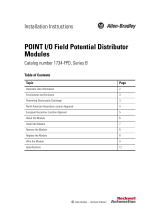 Rockwell Automation Allen-Bradley POINT I/O 1734-FPD Installation Instructions Manual
Rockwell Automation Allen-Bradley POINT I/O 1734-FPD Installation Instructions Manual
-
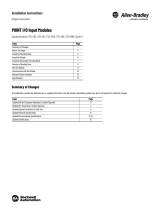 Allen Bradley Allen-Bradley 1734-IB2 POINT I/O Input Modules User manual
Allen Bradley Allen-Bradley 1734-IB2 POINT I/O Input Modules User manual
-
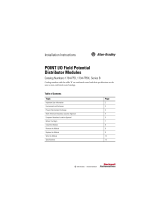 Rockwell Automation Allen-Bradley POINT I/O B Series Installation Instructions Manual
Rockwell Automation Allen-Bradley POINT I/O B Series Installation Instructions Manual
-
Rockwell Automation 1734D-IB16 User manual
-
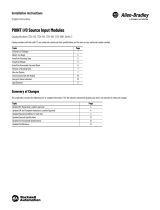 Allen Bradley Allen-Bradley 1734-IV2 POINT I-O Source Input Modules User manual
Allen Bradley Allen-Bradley 1734-IV2 POINT I-O Source Input Modules User manual
-
Spectrum Controls 1734sc-IF4U Owner's manual
-
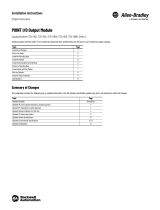 Allen Bradley Allen-Bradley 1734-OB2 POINT I/O Output Module User manual
Allen Bradley Allen-Bradley 1734-OB2 POINT I/O Output Module User manual
-
Spectrum Controls 1734sc-IF4U-1 Owner's manual
-
Automationdirect.com Productivity 2000 P2-08TD1P User manual
-
Bradley Smoker 1734-AENT User manual




























